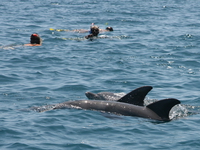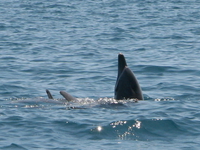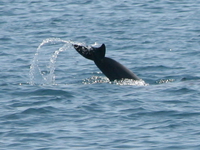dolphins
Dolphins are marine mammals that are closely related to whales and porpoises. There are almost forty species of dolphin in seventeen genera. They vary in size from 1.2 metres (4 ft) and 40 kilograms (88 lb) (Maui's Dolphin), up to 9.5 m (30 ft) and ten tonnes (the Orca or Killer Whale). They are found worldwide, mostly in the shallower seas of the continental shelves, and are carnivores, mostly eating fish and squid. The family Delphinidae is the largest in the Cetacea, and relatively recent: dolphins evolved about ten million years ago, during the Miocene. Dolphins are considered to be amongst the most intelligent of animals and their often friendly appearance and seemingly playful attitude have made them popular in human culture.
n 1933, three abnormal dolphins were beached off the Irish coast; these appeared to be hybrids between Risso's Dolphin and the Bottlenose Dolphin. This mating has since been repeated in captivity and a hybrid calf was born. In captivity, a Bottlenose Dolphin and a Rough-toothed Dolphin produced hybrid offspring. A Common-Bottlenose hybrid lives at SeaWorld California. Various other dolphin hybrids have also been reported in the wild, such as a Bottlenose-Atlantic Spotted hybrid. The best known hybrid however is the Wolphin, a False Killer Whale-Bottlenose Dolphin hybrid. The Wolphin is a fertile hybrid, and two such Wolphins currently live at the Sea Life Park in Hawaii, the first having been born in 1985 from a male False Killer Whale and a female Bottlenose. Wolphins have also been observed in the wild.
Most dolphins have acute eyesight, both in and out of the water, and their sense of hearing is superior to that of humans. Though they have a small ear opening on each side of their head, it is believed that hearing underwater is also if not exclusively done with the lower jaw which conducts the sound vibrations to the middle ear via a fat-filled cavity in the lower jaw bone. Hearing is also used for echolocation, which seems to be an ability all dolphins have. Their teeth are arranged in a way that works as an array or antenna to receive the incoming sound and make it easier for them to pinpoint the exact location of an object. The dolphin's sense of touch is also well-developed. However, dolphins lack an olfactory nerve and lobes and thus are believed to have no sense of smell, but they can taste and do show preferences for certain kinds of fish. Since dolphins spend most of their time below the surface normally, just tasting the water could act in a manner analogous to a sense of smell.
Though most dolphins do not have any hair, they do still have hair follicles and it is believed these might still perform some sensory function, though it is unclear what exactly this may be. The small hairs on the rostrum of the Boto river dolphin are believed to function as a tactile sense however, possibly to compensate for the Boto's poor eyesight.
Dolphins have a streamlined fusiform body, adapted for fast swimming. The basic colouration patterns are shades of grey with a light underside and a distinct dark cape on the back. It is often combined with lines and patches of different hue and contrast.
The head contains the melon, a round organ used for echolocation. In many species, the jaws are elongated, forming a distinct beak; for some species like the Bottlenose, there is a curved mouth which looks like a fixed smile. Teeth can be very numerous (up to two hundred and fifty) in several species. Dolphins breathe through a blowhole located on top of their head, with the trachea being anterior to the brain. The dolphin brain is large and highly complex and is different in structure from most land mammals.
Unlike most mammals, dolphins do not have hair, but they are born with a few hairs around the tip of their rostrum which they lose after some time, in some cases even before they are born. The only exception to this is the Boto river dolphin, which does have some small hairs on the rostrum.
Their reproductive organs are located on the underside of the body. Males have two slits, one concealing the penis and one further behind for the anus. The female has one genital slit, housing the vagina and the anus. A mammary slit is positioned on either side of the female's genital slit.




